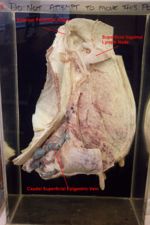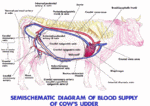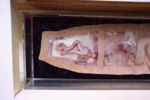Difference between revisions of "Cow Mammary Gland - Anatomy & Physiology"
Jump to navigation
Jump to search
| (7 intermediate revisions by 2 users not shown) | |||
| Line 1: | Line 1: | ||
| + | The mammary gland of the cow takes on added significance due to the importance of milk as a human food source. | ||
| + | |||
| + | |||
== General Structure == | == General Structure == | ||
| − | [[Image:Cow mammary gland labelled.jpg|thumb|right| | + | |
| − | + | [[Image:Cow mammary gland labelled.jpg|thumb|right|150px|Dissection of the Bovine Udder - Courtesy of Andrew Crook, Copyright RVC 2008]] | |
| + | |||
| + | * Mammary gland comprises four mammary complexes, which are separate units, consolidated in a single mass - the udder. | ||
| + | ** '''Udder''' hangs from the caudal abdomen and pelvis. | ||
| + | *** '''Quarters''': all four parts of the bovine udder, each associated with one teat. All four quarters are completely separated from each other. | ||
| + | |||
| + | * '''Accessory teats''', sometimes associated with functional glandular tissue common. | ||
| + | ** Undesirable, may complicate milking if fused or too close to principle teats. | ||
| + | |||
| + | |||
| + | |||
| + | |||
| + | |||
| + | |||
| + | |||
| + | |||
| + | |||
| + | |||
| + | |||
| + | |||
| + | |||
== Appearance == | == Appearance == | ||
| − | Varies greatly with breed. | + | * Varies greatly with breed. |
== Blood Supply == | == Blood Supply == | ||
| − | [[Image:Mammary Gland blood supply schematic.GIF|thumb|right| | + | [[Image:Mammary Gland blood supply schematic.GIF|thumb|right|150px|Schematic Diagram of the Blood Supply to the Bovine Udder - Copyright Prof. Pat McCarthy]] |
| + | |||
=== Arteries === | === Arteries === | ||
| − | + | ||
| + | |||
| + | * Main artery to the udder is a direct continuation of the '''external pudendal artery'''. | ||
| + | ** Enters the base of the udder on its dorsocaudal aspect after passing through the inguinal canal. | ||
| + | ** '''Forms a sigmoid flexure''' before dividing into a '''cranial and caudal mammary artery'''. | ||
| + | *** Sigmoid flexure permits the artery to stretch when the udder is full of milk, thus heavier than usual. | ||
| + | ** Mammary arteries anastamose with the '''superficial caudal epigastric artery''', which is connected to the '''cranial epigastric artery'''. | ||
| + | |||
| + | * Due to the requirement for extensive blood supply during lactation, there is a small contribution from the '''internal pudendal artery'''. | ||
| + | |||
=== Veins === | === Veins === | ||
| − | |||
| − | |||
| − | |||
| − | + | * Drainage from the udder is through | |
| − | + | ** '''External pudendal vein''' | |
| + | *** Drains through the inguinal canal | ||
| + | *** Sigmoid flexure to allow stretching when the udder fills. | ||
| + | ** '''Superficial cranial epigastric veins'''. | ||
| − | + | [[Image:Milk vein cow bovine POT288.jpg|thumb|right|150px|Dissection of the Bovine Udder to show the Milk Vein,Courtesy of Andrew Crook, Copyright RVC 2008]] | |
| − | + | * '''Superficial cranial and caudal epigastric veins''' anastamose to form the abdominal ''''milk vein'''': | |
| + | ** Large, tortuous on ventral abdomen. | ||
| + | ** Incompetent valves allow blood to flow in either direction. This is important for maintaining drainage of the extensive amount of blood present. For example, if the cow were to lay down, the thin walled veins on that side would be easily occluded. | ||
| + | ** passes through the abdominal wall caudal to the costal arch to join the internal thoracic vein, known as the ''''milk well''''. | ||
| − | Furstenburg's venous ring | + | * '''Furstenburg's venous ring''': the venous circle at the junction of the teat and gland sinuses. |
[[Category:Female Reproduction]] | [[Category:Female Reproduction]] | ||
| − | |||
| − | |||
Revision as of 18:08, 7 December 2010
The mammary gland of the cow takes on added significance due to the importance of milk as a human food source.
General Structure
- Mammary gland comprises four mammary complexes, which are separate units, consolidated in a single mass - the udder.
- Udder hangs from the caudal abdomen and pelvis.
- Quarters: all four parts of the bovine udder, each associated with one teat. All four quarters are completely separated from each other.
- Udder hangs from the caudal abdomen and pelvis.
- Accessory teats, sometimes associated with functional glandular tissue common.
- Undesirable, may complicate milking if fused or too close to principle teats.
Appearance
- Varies greatly with breed.
Blood Supply
Arteries
- Main artery to the udder is a direct continuation of the external pudendal artery.
- Enters the base of the udder on its dorsocaudal aspect after passing through the inguinal canal.
- Forms a sigmoid flexure before dividing into a cranial and caudal mammary artery.
- Sigmoid flexure permits the artery to stretch when the udder is full of milk, thus heavier than usual.
- Mammary arteries anastamose with the superficial caudal epigastric artery, which is connected to the cranial epigastric artery.
- Due to the requirement for extensive blood supply during lactation, there is a small contribution from the internal pudendal artery.
Veins
- Drainage from the udder is through
- External pudendal vein
- Drains through the inguinal canal
- Sigmoid flexure to allow stretching when the udder fills.
- Superficial cranial epigastric veins.
- External pudendal vein
- Superficial cranial and caudal epigastric veins anastamose to form the abdominal 'milk vein':
- Large, tortuous on ventral abdomen.
- Incompetent valves allow blood to flow in either direction. This is important for maintaining drainage of the extensive amount of blood present. For example, if the cow were to lay down, the thin walled veins on that side would be easily occluded.
- passes through the abdominal wall caudal to the costal arch to join the internal thoracic vein, known as the 'milk well'.
- Furstenburg's venous ring: the venous circle at the junction of the teat and gland sinuses.


